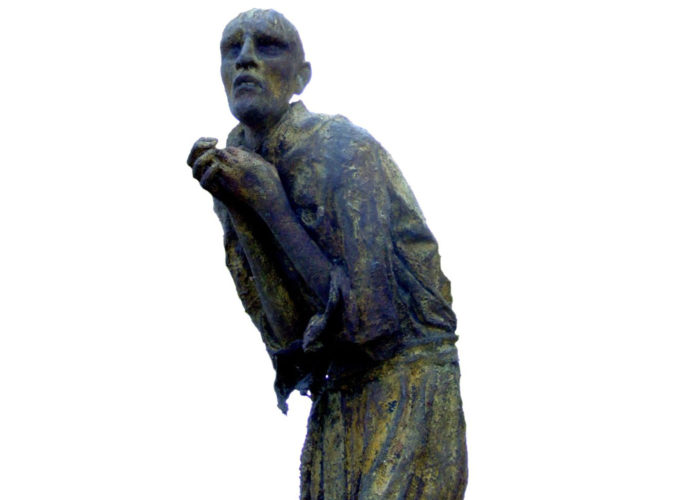The Apprehensive Man
Theme: Challenging law and order: British riots and reforms, Social and cultural revolution, Ireland's uprising (1798), British politics in the Age of Revolution, People in motion: exiles and opportunities
The Great Famine was a period of mass starvation and disease in Ireland. It lasted from 1845 to 1851, killing one million Irish people and leading to the migration of perhaps two million more. It became a watershed in Ireland’s history, permanently changing the demographic, political and cultural landscape. The ‘Apprehensive Man’ is one of a series of five bronze sculptures in the ‘Arrival’ series created by Irish artist Rowan Gillespie in 2007 and situated in Ireland Park in Toronto, Canada. It marks the arrival of thousands of starving Irish migrants in 1847.
The causes of the Great Famine are complex, but largely due to the potato blight which spread through Europe in the 1840s causing widespread failure of the potato crop. This failure proved catastrophic for Ireland, which relied particularly heavily on these crops. In the summer of 1847 (which would become known as ‘Black 47’), 38,560 desperate Irish men, women and children migrated to Canada, arriving in the then relatively small town of Toronto.
Travelling in overcrowded ‘coffin’ ships, the migrants endured terrible, disease-ridden conditions on their eight week long voyage across the Atlantic. Many died without reaching their destination. Despite initial attempts by the people of Toronto to treat the sick, over a thousand more succumbed to disease, malnutrition and hunger within a year of arrival. Many of those who survived moved beyond Toronto in search of work in North America, while others were able to re-establish ties with family and friends who had already settled in Canada over the previous 30 years.
The influx of these desperate people into Canada was not always welcome and provoked conflicts over land and religion, meaning the famine retained a powerful place in people’s collective memory and sense of community. The effects of the famine on Ireland were long lasting, and Irish people continued to migrate to North America – particularly to the United States – well into the 20th century. For the native Irish, the Great Famine endured in folk memory, becoming the focal point for Irish Nationalist movements and significantly damaging relations between Ireland and Britain due to the British laissez faire approach to the crisis.
Gillespie’s sculptures in Ireland Park provide a haunting and lasting reminder of this humanitarian crisis and of the struggle of the Irish people, forced to establish a new life far away from their homeland. They echo the figures in the artist’s ‘Departure’ memorial in Dublin, providing a symbolic link between the two cities.
Did you know..?
The population of Toronto in 1847 was just 20,000 people – almost half that of the number of migrants who arrived there from Ireland.
Sources & acknowledgements
This object description and its related educational resources were researched and written by our team of historians and education specialists. For further information see the item’s home museum, gallery or archive, listed above.
- Enquiry Questions
-
Did you know..?
The population of Toronto in 1847 was just 20,000 people – almost half that of the number of migrants who arrived there from Ireland.
-
Education overview
You can access a range of teachers resources related to this object and more on our education page.
Please also see our glossary of terms for more detailed explanations of the terms used.
-
Curatorial info
- Creator: Rowan Gillespie
- Creation Place: Ireland Park, Toronto, Canada
-
Use this image
You can download this image for personal and educational use but please take note of the license type and rights holder information.
- Rights Holder: Courtesy of Joshua Sherurcij
- License Type:
Open copyright with attribution.



